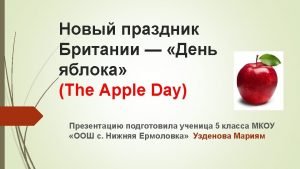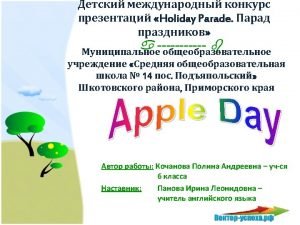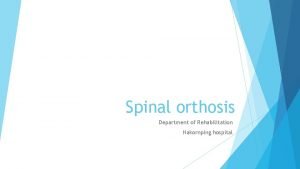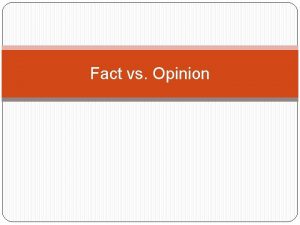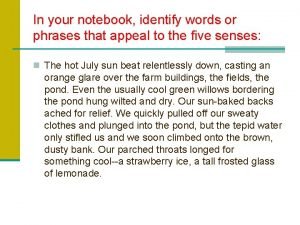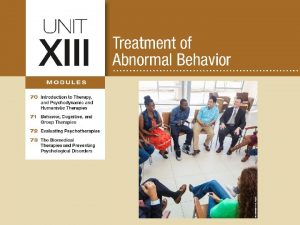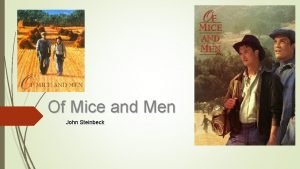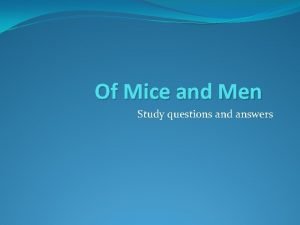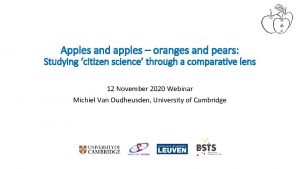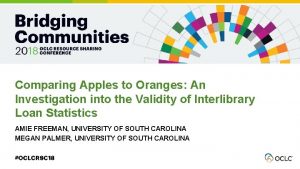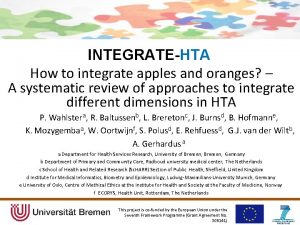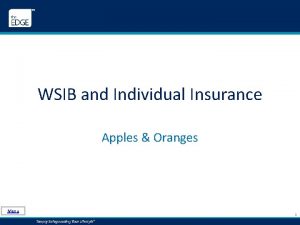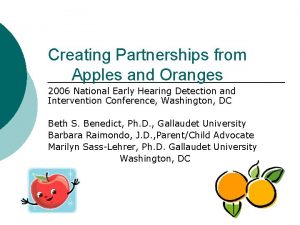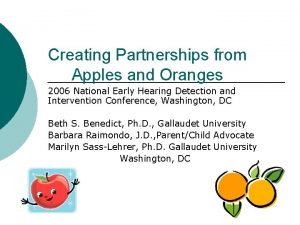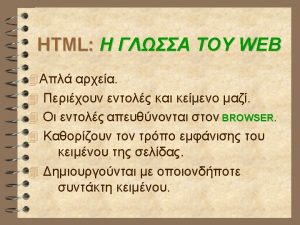Apples to Oranges James Flagler Dane Carlson Taylor



























- Slides: 27

Apples to Oranges James Flagler, Dane Carlson, Taylor Ligoci, Caryn Clendening, Maggie Curtis

Proposal � Our hypothesis: Students at VVS have a different statistical average use of i. Phones than that of the national average � Our population: Survey of 30, 000 cell- phone users, 10. 8% used i. Phones

Purpose A comparison between i. Phones students own at Vernon-Verona-Sherrill High School against the national average. � Expansion: compared various brands of phones students own against the national average with Samsung, LG, and Motorola. � Descriptive Statistics: elementary school, grade, type of phone, why he/she chose phone and whether or not phones should be allowed in hallways and study centers. � For surveyors that had an i. Phone, we asked the type and amount of usage. �

Investigation � Handed out surveys during all lunch periods, which was random � Descriptive statistics to showcase variables for why people have phones and effect of age/grade on answers � Comparison of not only i. Phones, but Samsung, LG and Motorola b/c of study

Procedure � � � Brainstorming: a lot of ideas, then stuck with hypothesis that VVS students have different result of i. Phones than national average. Research: found national averages to compare to the data we would collect. Proposal: expressed the intent of our idea and sought outside opinions for errors that could possibly occur before proceeding. Survey: worked out issues, created nine-question survey. Fair amount of questions meant avoiding as much bias and outside variables as possible. Asked for names to ensure no repeated surveys. Sampling: random sample because of three lunch periods, making sure all grade levels were eligible to take the survey.

Procedure: Continued � � � Counting: Once collected large enough amount, answers counted and organized by grade level, elementary schools, and whether they had an i. Phone or not. We eliminated any data that wasn’t usable. Graphs: made data more reader friendly Calculations: used all the data necessary to compute the margin of error and test our hypothesis. Presentation: with mathematical aspects and written aspects completed, created a one that showed our work and outcome. Evaluation: of work done, and how we could have handled the project differently.

Freshman: i. Phones Usage 14 12 10 8 6 4 2 0 Constant Often 12 9 Some 2 0 Rarely Some Often Constant i. Phone Owners by Town 2 Other Vernon 10 Sherrill Verona 6 Verona Sherrill Other 5 Vernon 0 2 4 6 Type of i. Phone Rarely 8 10 12 9 8 7 6 5 4 3 2 1 0 8 6 7 3 G 3 GS i. Phone 4 2 i. Phone 4 s i. Phone 5 0 3 G 3 GS i. Phone 4 s i. Phone 5

Freshman: Other Type of Phone 37 40 35 30 24 25 16 20 11 15 10 8 5 5 on e N th er O la M ot o ro LG ng su Sa m i. P ho ne 0

Freshman: All Phones Reason Why 25 22 $ 20 15 10 14 12 Quality Con 8 UF 5 2 Other 0 $ Quality Con UF Where Phones Should Be Allowed Other 70 60 50 40 30 20 10 0 Yes No Hallway Studyhall

Sophomore: i. Phone Elementary Schools 15 10 12 Generation 13 1 6 3 Gs 8 15 5 13 2 0 Vernon Verona Sherrill Other Usage 25 Often 10 Somet. . . 0 Rarely 0 0 10 20 4 s 5 ME: 3. 548% Const. . . 4 30

Sophomores: Other Sophomore Cell Phones 1 i. Phone Samsung 15 2 7 35 10 ME: 3. 548% Type of Cell Phone 21 25 20 15 10 10 4 3 5 1 0 Samsung LG Motorola Other None

Sophomore: Both Cell Phones in Hallways 1 Yes No Reason(s) Why Chose Phone Money 8 11 9 16 26 Quality Convenience User Friendliness Other 69 ME: 3. 548% Cell Phones in Study Halls 0 ME: 3. 548% Yes No 70 ME: 3. 548%

Juniors: i. Phones Amount of Use 4% 30% 65% Rarely Some Often Constant

Juniors: Other Brands of Phones 3% 15% 34% 8% 16% 23% i. Phones Samsung LG Motorola Other No Phone

Juniors: All Phones Reasons Why The Phone Was Used Other 18 6 User Friendly Convience 11 23 Quality Price 15 0 5 10 15 20 25

Seniors: i. Phones Elementary School 3, 70% Phone Usage 0 Rarely Sometimes Often Constantly 9 18 25, 90% 37, 00% 33, 33% Generation 0 0, 223 0, 407 0, 37 3 G 3 GS 4 4 S 5 Vernon Verona Sherrill Other

Seniors: Other 14, 70% 1, 10% 30, 60% 9, 10% 20, 40% 23, 80% i. Phone Samsung LG Motorola No Phone Other

Seniors: All Phones Should Students Be Able to Use Phones in Study Halls yes no 9% Should Students Be Able to Use Phones in Study Halls 91% 18, 20% 22, 70% 6, 80% Price Quality Should Students Be Able To Convenience User Friendliness Use Phones in the Halls Other 21, 60% 12, 50% 39, 80% 78, 40% yes no

Overall: i. Phone Usage Rarely Sometimes Often 3% Constantly i. Phones 33% 64% 100 70 63 80 60 35 23 40 88 73 27 25 20 4 41% 4 S 35% r Se ni o or ni ph o m an hm Ju 5 19% i. Phone Users Total So 1%4% Fr es 3 G 3 GS i. Phone Generations or e 0

Overall: Other What kind of Phones? 50 50 45 40 37 36 30 24 16 20 10 11 5 5 8 Samsung LG 24 20 23 21 25 15 i. Phone 31 35 Motorola 16 15 14 10 15 3 1 1 0 Freshman Sophomore Junior None 9 8 3 Other Senior

Phones Allowed in Hallways? Overall: Both 9% Yes No Grade and School 45 40 91% 35 30 Vernon 25 20 Verona 15 10 Sherrill 4% l Yes No To ta Se ni or Other Schools Fr es hm an So ph om or e Ju ni or 5 0 Phones in Study Halls? 22% 52% 26% 96% Vernon Verona Sherrill Other

Margin of Error: Different Margin of Error: E=Zc √(pq/n), n=294, 95% confident � i. Phone: p=. 108 q=. 892 ME=. 03548 or 3. 548% � Samsung: p=. 255 q=. 745 ME=. 04982 or 4. 982% � LG: p=. 206 q=. 794 ME=. 04623 or 4. 623% � Motorola: p=. 136 q=. 864 ME=. 03918 or 3. 918% �

Testing Hypothesis: Different � i. Phone: Ho-. 108 H 1 -≠. 108 a-0. 05 �Z=14. 70298, P≈0. 00000, P-value<a, p^=(110/294)=. 374. Reject Ho �Samsung: Ho=. 255, H 1≠. 255, a=0. 05 Z=-1. 60167, P=. 10923, P>a, p^=(63/264)=. 214. Do not reject Ho �LG: Ho=. 206, H 1≠. 206, a-0. 05 Z= -2. 38862, P=. 01691, P<a, . Reject Ho �Motorola: Ho=. 136, H 1≠. 136, a=0. 05, p^=(15/294)=. 05102. Z=-3. 57016, P=. 00036, P<a. Reject Ho

Testing Hypothesis: < or > i. Phone: Ho: . 108 H 1>. 108, p^=. 374, z=14. 70298, p≈0. 00000, p<a. Reject Ho � Samsung- Ho: . 255 H 1<. 255, p^=. 214, z=1. 60167, p=0. 05461, p>a. Do not reject Ho � LG- Ho=. 206 H 1<. 206, p^=. 14966, z=2. 38862, p=0. 00846, p<a. Reject Ho � Motorola- Ho: . 136 H 1<. 136 p^. 06463, z=3. 57016, p= 0. 00018, p<a. Reject Ho. �

Evaluation: Bias, Error, Lurking Variables Bias: Some may have not wanted to choose “constantly”-negative connotation, � Error: We may have counted some surveys incorrectly, some people answered the questions incorrectly, miscalculations could occur � Lurking Variables: population- does not have same specific age group and was from 2011 location-not all people in school go to lunch, friends may have influenced answers, embarrassment at type of phone, �

Evaluation: Improvement � Used an online survey service in order to avoid counting error � One question could be removed because of complications � Another question should have said (choose one) to avoid multiple answers � Biases such as age difference, friend influence and personal opinion could have been avoided

Evaluation: Final Statement � The survey worked exceptionally well � Little error � Collection was quick and rather simple � Group work was spectacular, worked well together and efficiently
 Apples here apples there
Apples here apples there Apples juicy apples round poem
Apples juicy apples round poem Apples juicy apples round poem
Apples juicy apples round poem Apples here
Apples here Taylor brace vs knight taylor brace
Taylor brace vs knight taylor brace Flagler hospital billing department
Flagler hospital billing department Kenan flagler cover letter template
Kenan flagler cover letter template Palm coast police department
Palm coast police department Pumpkin new world or old world
Pumpkin new world or old world Connotation tpcastt
Connotation tpcastt Oranges contain both calcium and vitamin c. fact or opinion
Oranges contain both calcium and vitamin c. fact or opinion Is a rusting bicycle a chemical or physical change
Is a rusting bicycle a chemical or physical change Alliteration in oranges by gary soto
Alliteration in oranges by gary soto There isn't any
There isn't any Gary soto character traits
Gary soto character traits The very hungry caterpillar stomachache
The very hungry caterpillar stomachache Imagery in oranges by gary soto
Imagery in oranges by gary soto David carpenter serial killer
David carpenter serial killer Clay lawson and russell odom
Clay lawson and russell odom Carlson
Carlson Coordinated management of meaning theory examples
Coordinated management of meaning theory examples Module 70 introduction to therapy
Module 70 introduction to therapy Carlson design hull designer
Carlson design hull designer Old russian animation
Old russian animation Cauda pancreatis
Cauda pancreatis Character traits of lennie
Character traits of lennie Bob carlson retirement watch
Bob carlson retirement watch Of mice and men--study questions answers chapter 3
Of mice and men--study questions answers chapter 3

